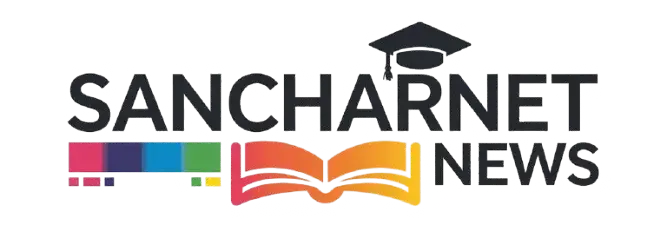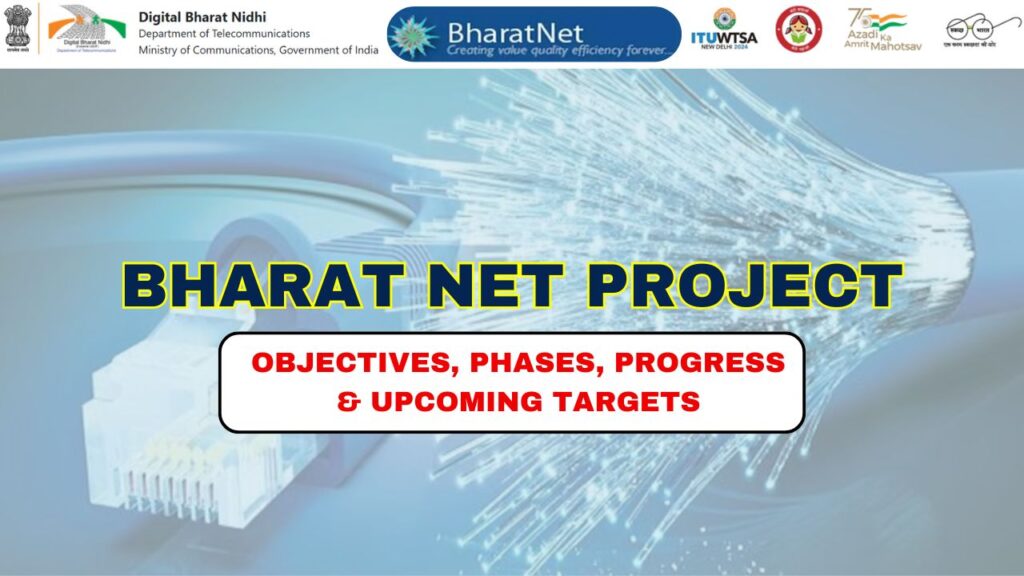BHARAT NET PROJECT: The department of Telecommunications (DOT) has reveled draft regulations aiming at creating the Digital Bharat Nidhi (DBN), which is a new initiative designed to take place of the Universal Service Obligation Fund. Under the Department of Tele Communication, there are several schemes and projects are running under the surveillance of the government. Bharat Net project is one of them.
Let us know about BHARAT NET PROJECT
- The National Optical Fiber Network has started in October 2011 and became the Bharat Net Project in 2015.
- This is the largest rural broadband program in the world that uses Optical Fiber technology.
- This project is a step towards strengthening the network world, managed by Bharat Broadband Network Ltd. (BBNL).
- BBNL comes under Special Purpose Vehicle (SPV) established by the Indian government under the Companies Act of 1956.
- The department of Tele Communication is a part of the Ministry of Communications and it is responsible for implementing this BHARAT NET project.
Goal
- The main purpose of this project is to change the execution approach by involving Village Level Entrepreneurs (Udyamis) to extend fiber connections to remote areas.
- Hopefully this strategy will speed up the connectivity process over the next 2.5 years.
Funding
- Apart from all this let us know about the funding process.
- Funding for the project comes from the Universal Service Obligation Fund (USOF).
- The aim of USOF is to provide universal access to quality ICT services at affordable prices for rural and remote communities.
- In 2002, Ministry of Communications in has established this fund.
Assam Circle Offers New Super Saving Plans- Family pack and Jeevan Sathi plan [Complete Guide]
RRB NTPC Exam Date 2025 Live | CBT Exam Date April [Exp], UG PG Exam Admit Card Download
BHARAT NET Project Objectives
- This project aims at giving a tough competition to private entities like Jio and Airtel.
- Through this project it will capture the rural areas where companies are less active.
- BharatNet aims to attract users by offering high-quality service.
- The current goal is to connect all 640000 villages in India with high speed internet services.
- The plan of BharatNet is to provide broadband access to over 250,000 gram panchayats nationwide.
- The government wants to ensure at least 100 Mbps bandwidth at each Gram Panchayat.
- Mainly Bharat Net aims at providing internet literacy among the village areas.
- The project emphasizes improving internet connectivity in underserved areas.
- BharatNet aims to enhance digital inclusion for all citizens.
- The focus is on making reliable internet available to rural India.
Phases of Bharat Net Project
Phase-1:
- Phase 1 was approved in 2011 as the National Optical Fibre Network Project which is known as Bharat Net to enhance broadband facilities at the Gram Panchayat Level.
- This scheme aimed at connecting the block HQs to Gram Panchayats using existing fiber from public sector companies like Bharat Sanchar Nigam Limited and RailTel Corporation of India Limited.
- During this phase additional fiber was installed to fill the connectivity gaps leading to the Gram Panchayats.
- Phase-I of the project was completed by December 2017.
- Over 100,000 Gram Panchayats received broadband connectivity through the installation of underground Optical Fibre Cable lines.
Phase -2:
- Phase II was approved in 2017, by rectifying the errors of phase 1 and its aimed to support the Digital India Vision.
- After the phase 1, phase 2 has came up with updated facility by using a combination of media, including optical fiber, radio, and satellite, to connect Gram Panchayats (GPs).
- Various models will be used for implementation, such as State-led, Private Sector, and CPSU models, ensuring last-mile connectivity through Wi-Fi or other broadband options.
- The main focus was to connect all Gram Panchayats across the country by March 2019 using a mix of underground fiber, fiber over power lines, radio, and satellite.
- This phase has made to enhance digital access and improve connectivity in rural areas.
Phase-3:
- Phase 3 has done with the promise of building a reliable network chain in between 2019-2023.
- This network was established to feature fiber connections between districts and blocks.
- A ring topology will be used to ensure redundancy and enhance performance.
BSNL IPTV and Cinema Plus Plans 2025
RPF Constable Admit Card 2025 Download on 27 Feb, City on 21 Feb Exam Date 2nd to 20th March 2025
Progress of Bharat Net project till now
The goal was to expand fiber internet to all the households after building the infrastructure the BharatNet initiative.
- A pilot program was successfully carried out in 60,000 villages, partnering with locals to connect homes.
- This achievement opened doors for Udyamis to join the project, aiming to create jobs for about 250,000 individuals.
- Till now the government has linked around 194,000 villages, giving internet access to roughly 567,000 households.
- Also 351,000 fiber connections have been set up through the new BharatNet Udyami project.
Challenges faced
- There are several challenges faced during the implementation.
- The project has faced significant delays in its implementation timeline.
- Progress has been slower than expected with only 194,000 of the 640,000 targeted villages connected.
- Slow progress hampered the project’s effectiveness in reducing the Digital Divide in rural regions.
- Difficult terrain and inadequate road infrastructure complicate the connection of villages.
- Logistical challenges contribute to inconsistent internet service and connectivity problems.
- Technical issues like poor signal quality and network outages impact user satisfaction.
- Managing operations and resolving complaints in a decentralized system is complex.
- Coordination among local entrepreneurs is essential but challenging for effective management.
- Competition from private telecom companies like Jio and Airtel complicates BharatNet’s efforts.
- To attract users, BharatNet must provide competitive pricing and reliable service.
Upcoming Targets for 2025
| upcoming Targets | Description |
| Target 1: Make broadband policy universal | By 2025, all countries should have a funded National Broadband Plan (NBP) or strategy, or include broadband in their Universal Access and Service (UAS) Definition |
| Target 2: Make broadband affordable | By 2025, entry−level broadband services should be made affordable in low− and middle−income countries (LMlCs) at less than 2% of monthly Gross National lncome (GNl) per capita |
| Target 3: Get everyone online | By 2025, broadband−internet user penetration should reach 75% worldwide; 65% in LMlCs; and 35% in least developed countries |
| Target 4: Promote digital skills development | By 2025, 60% of youth and adults should have achieved at least a minimum level of proficiency in sustainable digital skills |
| Target 5: lncrease the use of digital financial services | By 2025, 40% of the world’s population should be using digital financial services |
| Target 6: Get MSMEs online | By 2025, improve connectivity of micro−, small− and medium sized enterprises (MSMEs) by 50%, by sector |
| Target 7: Bridge the gender digital divide | By 2025, achieve gender equality across all targets |







